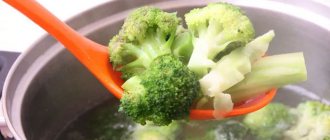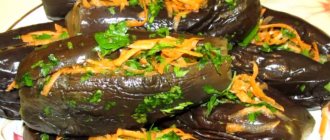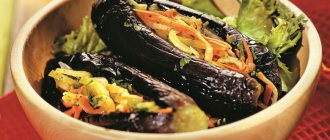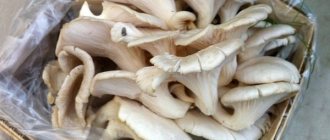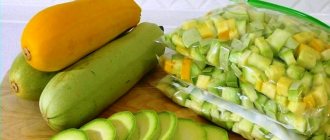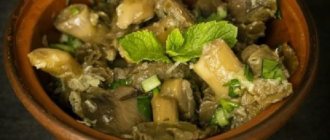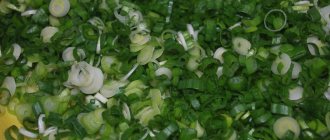How to freeze eggplants in the freezer
Eggplants are used to prepare various dishes. It can be frozen, but you need to know a few nuances so as not to be disappointed.
When eggplants are properly frozen, about 80% of the nutrients are retained in the fruit. And when canning, it is possible to save no more than 50%.
To properly freeze eggplants in the freezer, it is important to select and prepare the fruits correctly. For freezing, use young eggplants with undeveloped seeds. It is necessary to select completely healthy fruits without mechanical damage or signs of spoilage.
Advice! You should not try to freeze whole eggplants without first processing them. In this case, you will not get tasty vegetables, but a kind of rubber with a bitter taste.
To freeze vegetables, you need to prepare them; you can use fruits:
- soaked in saline solution;
- blanched in boiling water;
- fried in oil;
- baked in the oven.
Selection and preparation of eggplants
In order for the little blue ones to be well preserved, you need to select a quality product. Vegetables must have all the following criteria:
- the fruits must be ripe with even, smooth skin, without damage;
- the fruit should be heavy. On average, an eggplant 15 cm long can weigh under 500 g;
- medium-sized vegetables contain a small amount of corned beef, which means they will be less bitter than overgrown ones;
- the flesh of a fresh fruit is elastic; if you press it with your fingers, it will quickly restore its original shape;
- the stalk should be green, fresh, without wrinkled places;
- In a healthy fruit, the cut flesh is white without a distinct odor, and the seeds are light-colored.
Sick or damaged fruits, as well as vegetables with wrinkled skins, should not be used for storage. Overripe eggplants have no flavor and will not hold their shape once thawed.
General rules
Each option for freezing eggplants has its own nuances, but there are general rules:
- the temperature in the chamber where the fruits will be frozen and stored should not be higher than 12 degrees below zero. Only in this case, vegetables will ideally retain their taste and vitamins;
- It is not worth storing frozen eggplants for more than six months;
- It is necessary to freeze and store eggplants in hermetically sealed bags or containers with tight lids. The fact is that eggplants have the ability to absorb foreign odors, so when stored open, they can be “saturated” with the aroma of the products that lie nearby;
- It is not recommended to mix eggplants with other vegetables, that is, these vegetables are not suitable for preparing vegetable mixtures. We freeze eggplants separately and mix them with other vegetables only at the time of preparation;
- Before placing eggplants in the freezer, you need to thoroughly dry the vegetables. And if fried eggplants are frozen, then you need to blot off the excess oil.
Advice! Don’t forget to put labels on bags or containers that are frozen, indicating not only the name of the product, but also the date of freezing. The presence of such labels will allow you to quickly find the vegetables you need and monitor their shelf life.
Useful properties of the product
Eggplants, fresh and frozen, are rich in substances beneficial to human health:
- vitamins C and group B;
- microelements (calcium, phosphorus, potassium);
- pectin and fiber.
The vitamins that make up the vegetable are not very diverse, but eggplants are known for their low calorie content and pectin content, which improves the functioning of the digestive system and helps remove bile and excess cholesterol. Potassium rids the body of excess fluid and normalizes the functioning of the cardiovascular system. For these purposes, it is especially useful to consume baked or stewed fruits. Eggplants help prevent diseases such as atherosclerosis, anemia, osteoporosis, osteochondrosis, and gout.
Reference! Due to the content of vitamin PP (niacin) in eggplants, they help fight nicotine addiction, alleviating the symptoms of “nicotine starvation.”
The use of frozen eggplants is not fundamentally different from the use of fresh ones. However, the taste of the latter is more expressive and strong. For this reason, it is easier to prepare an appetizing dish from fresh, high-quality vegetables purchased in a store or market. And if this is not possible, frozen eggplants can be an excellent option to diversify your diet.
Watch the video! Freezing eggplants for the winter
Freezing fresh eggplant in cubes or slices
If you want to freeze fresh eggplants, you should proceed as follows:
- Wash the vegetables well, cut off the green tails;
- cut the eggplants into cubes or circles; the choice of cutting option depends on your taste and the list of dishes that you plan to prepare from frozen vegetables.
- Let's prepare a saline solution: pour cold water into a pan, add salt at the rate of 1 tablespoon (heaped) for each liter of water. Stir the water until the salt dissolves;
- pour the prepared solution over the chopped eggplants and leave for a couple of hours;
- Drain the eggplants through a colander, lightly squeeze and dry. Place the eggplants in tight freezer bags, remove the air from the bags and close them tightly. Place in the freezer.
Further uses of frozen eggplants
So, you have frozen the eggplants according to all the rules. Winter has come, you wanted something tasty, and then you decided to get a vegetable. But how to defrost it?
Defrosting rules
It is important to defrost eggplants gradually. To do this, you just need to transfer them to the refrigerator, where they will slowly thaw.
What not to do when defrosting:
- use a microwave;
- fill with water;
- refreeze the product.
If you are in a hurry, you can cook a frozen product; it will thaw during the cooking process.
What to cook
What dishes use frozen eggplants?
Fried potatoes with vegetables
Ingredients:
- 250 grams of frozen vegetables;
- 0.5 kg of potatoes;
- oil;
- salt;
- pepper;
- greenery.
The cooking method is simple. Fry the potatoes the way you are used to doing it. Fry thawed vegetables in a separate pan. When the potatoes are almost ready, add the eggplants, salt and stir. The finished dish can be decorated with herbs.
Vegetable stew
What you will need:
- eggplant;
- 1 tomato;
- onion;
- carrot;
- bell pepper;
- oil.
Cooking method:
- Prepare the vegetables: defrost the eggplants, grate the carrots, onion, garlic, chop the tomato.
- Fry the onion in vegetable oil until fully cooked.
- Add carrots to the prepared onions and fry until half cooked.
- Add the eggplants to the pan next, then the tomatoes.
- Fry everything until half cooked.
- Salt and pepper.
- Transfer the vegetables to a baking dish in the oven.
- Place the dish in the preheated oven for 35 minutes.
Eggplant caviar
It can be prepared from frozen vegetables. For this you will need:
- 0.5 kg frozen eggplants;
- 1 carrot;
- 1 onion;
- 2-3 tomatoes;
- 1 bell pepper;
- salt;
- oil.
How to cook:
- Fry the chopped onion and grated carrots until half cooked.
- Add eggplant.
- First cut the bell pepper into large cubes, place in a frying pan, cover with a lid and leave for 5 minutes.
- Chop the tomatoes, it is advisable to remove excess moisture.
- Add to vegetables, add salt.
- Cover with lid for another 5 minutes.
Advice. For a richer taste, do not defrost the eggplants completely before preparing the caviar.
Stewed vegetables in sour cream
The dish has a pleasant mild taste. To prepare you will need:
- 400-450 grams of vegetables;
- 300 grams of sour cream;
- 1 onion;
- salt;
- oil;
- water;
- greenery.
Cooking method:
- Grate the carrots on a coarse grater, cut the onion into cubes.
- Place the vegetables in a frying pan and fry.
- Add thawed eggplants.
- Cover with a lid and simmer.
- Are the vegetables fully cooked and soft? Add sour cream. There is a risk that the sour cream will curdle, so dilute it with 50 ml of water.
- Simmer for five minutes.
- At the very end, add salt and herbs.
Freezing blanched eggplants
Blanched eggplants store well and retain their taste perfectly when frozen. Prepare vegetables like this:
- wash the vegetables, cut them into cubes, bars or circles - as you like;
- Take a large saucepan, pour water, add salt to taste (the water should be noticeably salty) and pour in lemon juice at the rate of a tablespoon per liter of water. Instead of lemon juice, you can take a solution of citric acid;
- Place the chopped eggplants in a sieve or colander. We spread it loosely, without compacting it;
- put a hundred and eggplants into boiling water and let stand for two minutes;
- then remove the sieve filled with eggplants from the pan and immerse a bowl of ice water;
- when the eggplants have cooled, gently squeeze them out and dry them, spreading them out on paper towels;
- Place the vegetables in bags or containers, close tightly and place in the freezer.
Frozen blanched eggplants are great for preparing any dish. You can use them to make a stew or sauté, add them to sauces when stewing meat, or add them to pizza toppings after pre-frying. In addition, eggplants can simply be fried and stewed and served as a side dish for meat.
You can blanch the eggplants whole without cutting them into pieces. You need to do this:
- wash the eggplants;
- using a toothpick, make several deep punctures into the vegetables;
- Place the whole eggplant in boiling salted water and cook for minutes, depending on the size of the fruit;
- then remove the eggplants from the boiling water with a slotted spoon and let them cool;
- Lightly squeeze and dry the cooled eggplants well, put them in bags and put them in the freezer.
Boat-shaped eggplants for stuffing
- Wash and dry the eggplants thoroughly;
- cut the fruits in half;
- lower the halves into boiling water, to which salt has previously been added;
- boil for 10 minutes;
- prepare a basin or large bowl of water by adding ice to the water;
- Remove the boiled eggplant halves with a slotted spoon and immediately immerse them in ice water;
- after a couple of minutes, drain the water and let the eggplants cool slightly;
- Using a spoon, select the central part of the pulp from the halves, leaving approximately 1 cm on all sides;
- Dry the prepared “boats” with napkins to remove excess moisture;
- Place on a board or tray covered with cling film. We cover the halves on top with two more layers of film and put the board in the freezer;
- After a few hours, we take out the board, remove the films and put the “boats” into tight bags or containers, and put them in the freezer.
Freeze fried eggplant (for caviar, rolls)
You can freeze fried eggplants. This preparation is an excellent semi-finished product for caviar. Roasted vegetables can be added to almost finished stews and other dishes.
Procedure:
- wash the vegetables and dry them;
- cut the eggplants into circles or plates. If you cut the eggplants into thin slices lengthwise, then such a blank can be used for rolls with various fillings;
- Sprinkle the sliced eggplants with salt and wait for the juice to appear. Then rinse the pieces with cold water, squeeze and dry;
- if young vegetables are used, they can be fried without pre-treatment; young fruits contain practically no solanine. This substance is poisonous and is what gives eggplants their bitter taste;
- pour some oil into the frying pan. Fry the prepared eggplant pieces, laying them out in one layer and turning them from one side to the other;
Advice! You can use a grill pan for frying. In this case, nice fried stripes will appear on the surface of the vegetables. Using a grill pan will allow you to slightly reduce oil consumption, which will make the preparation less high in calories.
- Place the fried eggplants on paper towels to remove excess oil. Let the vegetables cool completely;
- take a cutting board or, for example, a spreader. The main thing is that the selected substrate fits freely into the freezer compartment;
- wrap the board with cling film. Place the fried vegetables on the board in one layer. Cover the top again with film and place the fried eggplants in a second layer. Repeat this until all the vegetables are gone. Cover the top layer of eggplants with two or three layers of film;
- place the resulting structure in the freezer and wait for the initial freezing;
- then we transfer the frozen vegetables into tight bags or airtight containers and put them in the freezer.
Before eating, the eggplants need to be thawed, then you can fry them a little more in a frying pan.
How to choose?
It is recommended to buy eggplants from mid-August to the end of September. It is during this time period that the vegetable appears ripe and at an inexpensive price.
So, what nuances do you need to know in order to choose the right vegetable:
Eggplant
- Initially, you need to pay attention to the appearance. Large ones contain a lot of seeds. It is for this reason that it is recommended to choose small or medium-sized specimens. They are tender and tasty.
- The skin should be clean and smooth. The presence of spots indicates disease. Such fruits cannot be used for preparations.
- The green tail of an eggplant is a fresh vegetable, recently harvested. Dry - has been sitting on the counter for a long time.
- Large ones are very bitter, so it will take a lot of time to soak. Young ones contain less solanine, and their taste is more delicate and pleasant. The latter do not need to be further soaked in salt water.
Freezing baked eggplants
You can freeze eggplants baked in the oven. To prepare various dishes, you can bake eggplants by cutting them into pieces. If you plan to use the fruits for stuffing, then they need to be baked and frozen whole.
Procedure for freezing baked eggplant pieces:
- wash the vegetables and cut them crosswise into slices or slices;
- sprinkle the eggplants with a little salt;
- Grease a baking sheet or mold with vegetable oil. The baking sheet can be pre-lined with foil;
- Place the eggplant pieces in one layer. Bake for half an hour at 180 degrees. Transfer the prepared vegetables to a large dish and cool;
- Place the pieces on a board covered with cling film. Cover the layer of vegetables again with film. Then you can spread out the second layer of baked eggplants. When the last layer is laid out, you need to wrap the board with vegetables in two or three layers of cling film and put it in the refrigerator;
- When the pieces are frozen, pour them into a container or put them in bags. Cover the containers with a lid, remove excess air from the bags and close them. Place in the freezer.
You can bake eggplants whole. For this:
- wash the vegetables, dry them, do not cut off the stalks yet;
- We make several deep punctures in each fruit with a toothpick;
- place the vegetables on a wire rack or on a baking sheet lined with parchment or foil;
- bake for about 1 hour at 180 degrees;
- then take out the vegetables and let them cool;
- Cut off the stem of the finished, cooled eggplants;
- then we make a deep longitudinal cut on each eggplant, without cutting through the vegetable all the way. Use your hands to slightly spread the incision;
- Place the vegetables on the grill cut side down, cover the top with a cutting board or other suitable object, place a weight on the board and leave for 2-3 hours;
- The stuffing preparation is ready, you need to freeze it. To do this, we wrap each fruit in two or three layers of cling film or put it in freezer bags or in a container and transfer the vegetables to the freezer.
Basic Rules
Self-freezing of fruits, vegetables and mushrooms for the winter is currently actively practiced and gaining momentum. Moreover, if you freeze eggplants correctly, they will retain the maximum amount of microelements important for health. Let's figure out how to properly freeze eggplants at home in the freezer for the winter.
- Selection of vegetable crops.
To freeze, you need to buy ripe fruits, with a uniformly colored and elastic surface without cracks or stains, since pathogenic microorganisms accumulate in them. It has been noticed that in young nightshades the level of harmful microelements is minimal.
- When storing in the freezer, avoid temperature changes.
At home, freezing eggplants for the winter involves packaging them in portions - for 1 cooking time. This is due to the fact that nightshade cannot be re-frozen. To freeze the product efficiently, the temperature at the storage location should not fall below – 12 degrees.
- Culinary experts recommend freezing blue fruits separately.
Therefore, if you plan to prepare a cocktail for stew, then pack the eggplants separately.
- Slicing and heat treatment is required.
Preparing eggplants for the winter and their subsequent freezing should be done in sliced form. This is due to the fact that the whole fruit will become rubbery in consistency, and in the absence of heat treatment, its taste will become bitter.
- When cutting vegetables, pay attention to the color of the cut.
If it is dark, then it is better to get rid of it, since there is an excess of a toxic substance inside - solanine. Dark spots can be cut out with a knife. Remember, a healthy nightshade should have a light cut.
- Control of deadlines.
Before freezing the cuts, prepare not only storage containers, but also notes with the date and name of the stock for the winter, so as not to expire its expiration date. It is worth noting that the shelf life of eggplants in frost conditions is 180 days.
- Container for freezing.
The main thing is that the packaging material for eggplants for the winter is airtight. This will help avoid contact with air. For freezing, nylon containers or plastic bags are perfect.
How to store and use
Frozen eggplants should be stored in the freezer, avoiding thawing and re-freezing.
Eggplants, frozen in cubes or slices, do not need to be defrosted to prepare the dish. They are poured directly from the bag into a frying pan or saucepan. If you plan to cook rolls or stuffed eggplants, then the vegetables need to be thawed. This should be done gradually, at room temperature.
You should not defrost vegetables in the microwave, as this will ruin their structure. It is better to spend more time and wait until the vegetables melt on their own. After this, the fruits are handled according to the recipe.

